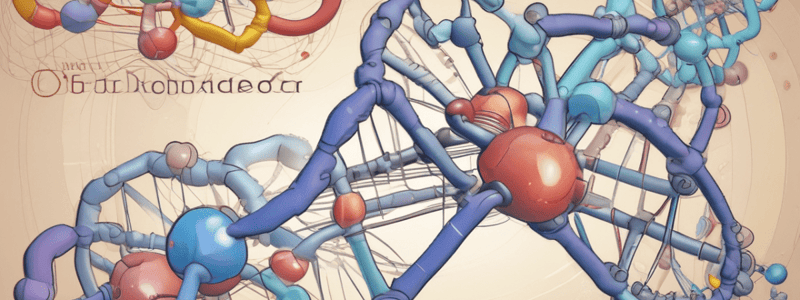Podcast
Questions and Answers
What type of bonds contribute to the stabilization of the three-dimensional tertiary structure of a protein?
What type of bonds contribute to the stabilization of the three-dimensional tertiary structure of a protein?
- Phosphodiester bonds
- Peptide bonds
- Hydrogen bonds (correct)
- Disulfide bonds
What is the arrangement of polymeric polypeptide subunits in three-dimensional complexes called?
What is the arrangement of polymeric polypeptide subunits in three-dimensional complexes called?
- Secondary structure
- Quaternary structure (correct)
- Primary structure
- Tertiary structure
Which of the following proteins is an example of a monomeric protein?
Which of the following proteins is an example of a monomeric protein?
- Myoglobin (correct)
- Insulin
- Hemoglobin
- Lactate dehydrogenase
What type of interactions hold subunits of polymeric proteins together?
What type of interactions hold subunits of polymeric proteins together?
Which of the following forces is NOT involved in stabilizing the quaternary structure of proteins?
Which of the following forces is NOT involved in stabilizing the quaternary structure of proteins?
What type of proteins have a quaternary structure?
What type of proteins have a quaternary structure?
What type of structure is formed when a polypeptide chain is twisted by equal amounts about each α-carbon?
What type of structure is formed when a polypeptide chain is twisted by equal amounts about each α-carbon?
Which type of protein structure is composed of two or more polypeptide chains?
Which type of protein structure is composed of two or more polypeptide chains?
What is the distance between nitrogen and oxygen atoms in hydrogen bonds in α-helix?
What is the distance between nitrogen and oxygen atoms in hydrogen bonds in α-helix?
In which type of protein structure are hydrogen bonds perpendicular to the polypeptide backbone?
In which type of protein structure are hydrogen bonds perpendicular to the polypeptide backbone?
What is the relationship between the CO group of an amino acid and the NH group in an α-helix?
What is the relationship between the CO group of an amino acid and the NH group in an α-helix?
What is the arrangement of polypeptide chains in a parallel pleated sheet?
What is the arrangement of polypeptide chains in a parallel pleated sheet?
What is the name of the protein that is an example of a tertiary structure?
What is the name of the protein that is an example of a tertiary structure?
What is the significance of the folding of a polypeptide chain in tertiary structure?
What is the significance of the folding of a polypeptide chain in tertiary structure?
What is the primary structure of proteins composed of?
What is the primary structure of proteins composed of?
What is the result of the peptide bond formation between amino acids?
What is the result of the peptide bond formation between amino acids?
What is the importance of knowing the primary structure of proteins in genetic diseases?
What is the importance of knowing the primary structure of proteins in genetic diseases?
What is proinsulin converted to by the loss of C-peptide?
What is proinsulin converted to by the loss of C-peptide?
What is the result of hydrogen bonding between the hydrogen of NH and oxygen of C=O groups?
What is the result of hydrogen bonding between the hydrogen of NH and oxygen of C=O groups?
Approximately how many amino acids apart in the linear sequence protein are hydrogen bonds formed?
Approximately how many amino acids apart in the linear sequence protein are hydrogen bonds formed?
What is the difference between primary and secondary structure of proteins?
What is the difference between primary and secondary structure of proteins?
What is the objective of learning about the structure and function of proteins?
What is the objective of learning about the structure and function of proteins?
Study Notes
Primary Structure of Proteins
- The sequence of amino acids forming the backbone of proteins are joined covalently by peptide bonds.
- Peptide bonds are formed between the α-carboxyl group of one amino acid and the α-amino group of another with the elimination of a water molecule.
- Clinical importance: many genetic diseases are due to abnormal amino acid sequences, and knowledge of primary structure can be used to diagnose or study the disease (e.g., Sickle cell disease).
- Proinsulin is a single polypeptide chain with 86 amino acid, converted to active insulin by loss of C-peptide.
Secondary Structure of Proteins
- Hydrogen bonding between the hydrogen of NH and oxygen of C=O groups of the polypeptide chain occurs, forming secondary structure.
- Two important kinds of secondary structure:
- α-Helix (helicoidal structure): stabilized by hydrogen bonds between NH and CO groups of the same chain, with an optimal nitrogen to oxygen (N-O) distance of 2.8 Å.
- β-Pleated sheet structure: composed of two or more polypeptide chains, stabilized by hydrogen bonds between NH and C=O groups in different polypeptide chains.
Tertiary Structure
- The peptide chain, with its secondary structure, may be further folded and twisted about itself, forming a three-dimensional arrangement of the polypeptide chain.
- Amino acid residues distant from each other in the sequence can be brought near due to folding, forming regions essential for protein function (e.g., active site or catalytic site of enzymes).
- Tertiary structure is stabilized by:
- Hydrogen bonds
- Hydrophobic interactions
- Van der Waals forces
- Disulfide bond
- Ionic (electrostatic) bonds or salt bridges.
Quaternary Structure of Protein
- Only proteins with more than one polypeptide chain (polymeric) have a quaternary structure.
- Not all proteins are polymeric, some are monomeric (e.g., myoglobin).
- The arrangement of polymeric polypeptide subunits in three-dimensional complexes is called the quaternary structure of the protein.
- Examples of proteins with quaternary structure: Hemoglobin (Hb), Lactate dehydrogenase.
- The subunits of polymeric protein are held together or stabilized by:
- Hydrophobic interactions
- Hydrogen bond
- Ionic bonds
- Van der Waals forces.
Studying That Suits You
Use AI to generate personalized quizzes and flashcards to suit your learning preferences.
Description
This quiz covers the structure and function of proteins, as part of Clinical Biochemistry lecture no. 3.




